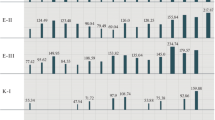Summary
The natural population of Drosophila subobscura of Mt. Parnes has been followed for two successive years and the frequency of the gene arrangements determined. Some changes occured in the first year but do not explain the existence of the geographical clines for these frequencies. Within the second year no changes were observed. For chromosomes J and U there is evidence for a greater fitness of the heterozygotes.
Experiments on temperature effect on viability of adult male flies, on their temporal sterility, on the viability of flies during all their biological cycle and experiments on the effect of dryness on the viability of adult male flies did not show an important change of gene arrangement frequencies in the resistant individuals. Nor did diapausing females have very different gene arrangements, except for chromosome O. Cage experiments with temperature as a selective agent did not elucidate the action of this factor. It is concluded that temperature or dryness do not affect very much the polymorphic system, nor explain the existence of these clines.
This polymorphic system is much more stable in D. subobscura than in D. pseudoobscura, its nearctic relative. It is also richer. It is concluded that it is historically older and helps the populations to cope with many environmental changes.
Similar content being viewed by others
Literature
Allison, A. C.: Genetic factors in resistance to malaria. Ann. N. Y. Acad. Sci. 91, 710 (1961).
— B. A. Askonas, N. A. Barnicot, B. S. Blumberg, and C. Krimbas: Deficiency of erythrocyte glucose-6-phosphate dehydrogenase in Greek populations. Ann. hum. Genet. 26, 237–242 (1963).
Barnicot, N. A., A. C. Allison, B. S. Blumberg, G. Deliyannis, C. Krimbas, and A. Ballas: Haemoglobin types in Greek populations. Ann. hum. Genet. 26, 229–236 (1963).
—, C. Krimbas, R. B. McConnell, and G. H. Beaven: A genetical survey of Sphakia, Crete. Hum. Biol. 37, 274–298 (1965).
Burla, H., u. W. Götz: Veränderlichkeit des chromosomalen Polymorphismus bei Drosophila subobscura. Genetica 36, 83–104 (1965).
Cain, A. J., and P. M. Sheppard: Natural selection in Cepaea. Genetics 39, 89–116 (1954).
Currey, J. D., R. W. Arnold, and M. A. Carter: Further examples of variation of populations of Cepaea nemoralis with habitat. Evolution (Lawrence, Kansas) 18, 111–117 (1964).
Da Cunha, A. B., H. Burla, and Th. Dobzhansky: Adaptive chromosomal polymorphism in Drosophila willistoni. Evolution (Lancaster, Pa.) 4, 212–235 (1950).
—, and Th. Dobzhansky: A further study of chromosomal polymorphism in Drosophila willistoni in relation to environment. Evolution (Lancaster, Pa.) 8, 119–134 (1954).
Dobzhansky, Th.: Genetics and the origin of species, 3rd ed., p. 364. New York: Columbia University Press 1951.
—: Rigid visus flexible chromosomal polymorphism in Drosophila. Amer. Naturalist 96, 321–328 (1962).
—: “Wild” and “Domestic” species of Drosophila. In: The genetics of colonizing species, p. 533–546. New York: Academic Press 1965.
Ford, E. B.: Ecological genetics, p. 335. London: Methuen 1964.
Krimbas, C. B.: The genetics of Drosophila subobscura populations. I. Inversion polymorphism in populations of Southern Greece. Evolution (Lawrence, Kansas) 18, 541–552 (1964a).
—: The genetics of Drosophila subobscura populations. II. Inversion polymorphism in a population from Holland. Z. Vererbungsl. 95, 125–128 (1964b).
Kunze-Mühl, E., u. D. Sperlich: Qualitative, quantitative und jahreszeitliche Untersuchungen über den chromosomalen Polymorphismus natürlicher Populationen von Drosophila subobscura. Coll. in der Umgebung von Wien. Z. Vererbungsl. 89, 636–646 (1958).
McFarquhar, A. M., and Forbes W. Robertson: The lack of evidence for coadaptation in crosses between geographical races of Drosophila subobscura Coll. Genet. Res. 4, 104–131 (1963).
Pentzou-Daponte, A.: Genetic analysis of the chromosomal polymorphism of a greek population of Drosophila subobscura [Thesis in Greek], 123 p. Thessaloniki 1964a.
Pentzou-Daponte, A.: Qualitative und quantitative Untersuchungen über den chromosomalen Polymorphismus uatürlicher Population von Drosophila subobscura in der Umgebung von Thessaloniki, Griechenland. Z. Vererbungsl. 95, 129–144 (1964b).
Prevosti, A.: Chromosomal polymorphism in Drosophila subobscura populations from Barcelona [Spain]. Genet. Res. 5, 27–38 (1964).
Sheppard, P. M.: Fluctuations in the selective value of certain phenotypes in the polymorphic land snail Cepaea nemoralis (L.). Heredity 5, 125–134 (1951).
—: Natural selection in two colonies of the polymorphic snail Cepaea nemoralis. Heredity 6, 233–238 (1952).
Sperlich, D.: Chromosomale Strukturanalyse und Fertilitätsprüfung an einer Marginalpopulation von Drosophila subobscura. Z. Vererbungsl. 95, 73–81 (1964).
Author information
Authors and Affiliations
Rights and permissions
About this article
Cite this article
Krimbas, C.B. The genetics of Drosophila subobscura populations. Molec. Gen. Genet. 99, 133–150 (1967). https://doi.org/10.1007/BF00426158
Received:
Issue Date:
DOI: https://doi.org/10.1007/BF00426158



